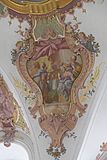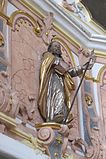Assumption of Mary (Walleshausen)
The Catholic parish church of the Assumption of Mary in Walleshausen , a district of the municipality of Geltendorf in the Upper Bavarian district of Landsberg am Lech , was built in the second half of the 15th century on the foundations of a previous Romanesque building. The church was probably the destination of a pilgrimage from the 16th century . In the 17th and 18th centuries, the church was redesigned in the Baroque and Rococo styles .
history
The parish church of the Assumption of Mary goes back to a Romanesque church building, which is referred to in a letter of indulgence from 1344 as "Ecclesia Sanctae Mariae". The substructure of the tower is still preserved from this original choir tower church . After the parish was incorporated into the Augustinian Canons of Polling in the middle of the 15th century, the new Gothic building of the church began, and the foundation stone was laid in 1466. At the end of the 17th century, the church was made Baroque . The tower octagon was built in 1695, presumably under the direction of Michael Natter. In 1732 work began on redesigning the interior in the early Rococo style . The stucco work was done by Franz Xaver Feuchtmayer , one of the most famous artists of the Wessobrunn school . The frescoes were done by Johann Georg Wolcker .
Pilgrimage
In the 16th century, the pilgrimage to a figure of the penitent Maria Magdalena , who had been brought from Hungary by a participant in the war against the Turks , probably began . A complete indulgence could be obtained with the pilgrimage . The no longer preserved sculpture of Magdalena was marked with the year 1518 and depicted the saint with only her body-length hair.
architecture
Exterior construction
The church is located in the middle of a cemetery, which is surrounded by a Gothic fortification. In the south an originally roofed staircase leads to a gatehouse , in the west a pointed arched gate has been preserved. The ossuary , which was built in 1453, dates back to the time before the Gothic church was built. In its upper part there is a Mount of Olives chapel with baroque sculptures by Heinrich Hagn and repeatedly renewed wall paintings.
The bell tower covered with an onion dome rises in the southern corner of the choir . The three-storey, octagonal structure is reinforced by corner pilasters and is broken up by numerous sound arcades . The nave is structured on the outside by stepped buttresses.
inner space
The single-nave interior is covered by a needle cap barrel. The four bays of the nave rest on strong, profiled pilasters . Another round arch opens up to the retracted choir , which closes with a quintuple .
Piece
On the choir arch , two angels hold a double stucco cartouche , which refers to the founding legend of the Polling monastery, to which the parish Walleshausen belonged from the middle of the 15th century. The upper cartouche shows the Tassilo cross , the lower one a doe. Both representations are reminiscent of the Bavarian Duke Tassilo III. , the legendary founder of the monastery, who, according to tradition, pursued a doe while hunting, which is said to have carved a cross out of the ground where the monastery was later built.
A rich stucco decoration of bandwork , gilded latticework on a green background, leaf and flower tendrils surrounds the picture fields. Green leaf tendrils with gilded flowers sprout from the stucco frames. The ceiling of the nave is also adorned with putti and angel heads wrapped in clouds.
Ceiling frescoes
The ceiling frescoes in the choir are dedicated to Mary . The main picture bears the painter's signature "JG Wolcker Aug. pinx." (Johann Georg Wolcker Augustanus painted it) and depicts the Assumption of Mary . The two colored cartouche frescoes and the images of the stabbing caps in Camaïeu technique also refer to the veneration of Mary.
The frescoes in the nave are related to the pilgrimage and the veneration of Maria Magdalena, the church's patron saint. The large ceiling paintings above the gallery depict the women at the empty tomb and the encounter between Mary Magdalene and the risen One ( Noli me tangere ).
On the central ceiling fresco, Mary Magdalene, accompanied by angels playing music, is taken into heaven, which is symbolized by the eye of God at the top of the picture . Maria Magdalena is wrapped in a wide, blue cloak, her body is only covered by her hair. Her attributes , the skull and the cross, are shown in the lower left half of the picture . At the bottom of the picture you can see three intertwined figures. A putto with a bow and arrow symbolizes amor carnalis , carnal love, the naked male figure with dragon wings and clawed feet represents the devil and the sumptuously dressed woman embodies the vice of pride with her peacock feather on her head, with her jewelry vanity and through the mask she holds in her hand, the falsehood.
The six cartouche pictures contain scenes of Mary Magdalene's encounter with Jesus. In the first scene, Mary Magdalene, elegantly dressed, listens to Jesus' sermon. The next picture depicts the feast at Simon the Pharisee's, at which Mary Magdalene dries Jesus' feet with her hair. In another scene, Jesus is the guest of Mary Magdalene and Martha . Mary Magdalene listens to the words of Jesus while Martha works in the kitchen. Martha is reprimanded by Jesus for her rebuke to Mary Magdalene. Another scene shows the raising of Lazarus from the dead. One picture shows Mary Magdalene pouring anointing oil over the head of Jesus. In the last scene, Mary Magdalene is standing at the foot of the cross.
The monochrome pictures in the camaïeu technique in the stitch caps are emblematic representations on the subject of penance.
West gallery
The double gallery was built in around 1690 as part of the baroque style of the church. The oil painting on the upper parapet depicts Magdalena's crossing over the sea. According to the tradition of the Legenda aurea , Mary Magdalene with her siblings Martha and Lazarus and other companions are said to have been abandoned in a ship and stranded in the south of France in Les Saintes-Maries-de-la-Mer near Marseille .
The lower parapet is divided into 13 fields, which are framed by stucco and painted with marble imitations. In front of the fields are small figures of the twelve apostles and Jesus in the middle. They are attributed to Heinrich Hagn (1642–1715) from Weilheim.
Furnishing
- The pulpit was created in 1774 in the late Rococo style by Maximilian Gruber. The pulpit basket is decorated with the carved figures of the evangelists Markus , Lukas and Matthew and their symbols by Franz Xaver Schmädl . The Evangelist John is shown in the painting on the back wall of the pulpit.
- In the center of the six-column high altar from around 1760 is a late Gothic Mother of Sorrows, which was acquired in the 1950s.
- The side altars date from 1730/40. The left side altar is dedicated to the patron saint of the church, St. Mary Magdalene. The side figures of St. Barbara and St. Margaret were created by Joseph Hagn (1686–1764), the son of Heinrich Hagn. The original Magdalene figure from Hungary has now been replaced by a baroque sculpture acquired in the 1950s. The sculptures of St. Lawrence and St. Anthony on the right side altar, the Sebastian Altar, are also by Joseph Hagn. The life-size carved figure of St. Sebastian was probably already in 1723 at the founding of Sebastian's brotherhood in Ehrgott Bernhard Bendl commissioned. Another altar, the Augustine altar, with a figure of the saint and patron saint of the Augustinian canons by Joseph Hagn is built into a niche on the north wall of the nave.
- The Pietà on the south wall of the nave is also attributed to Joseph Hagn.
- The life-size representation of Christ on the scourge column on the north wall of the nave from around 1735 comes from the workshop of Ignaz Hillenbrand .
literature
- Georg Dehio : Handbook of German Art Monuments - Bavaria IV - Munich and Upper Bavaria . 2nd edition, Deutscher Kunstverlag, Munich 2002, ISBN 3-422-03010-7 , p. 1241.
- Lore Lüdicke: The parish church Walleshausen and its vault decoration: stucco and ceiling paintings . In: Walter Brandmüller (Ed.): Walleshausen. The little polling . Anton H. Konrad Verlag, Weißenhorn 1985, ISBN 3-87437-235-9 , pp. 107-127.
- Wilhelm Neu: The sculptures of the parish church . In: Walter Brandmüller (Ed.): Walleshausen. The little polling . Anton H. Konrad Verlag, Weißenhorn 1985, ISBN 3-87437-235-9 , pp. 128-134.
- Petar Vrankić, Anton H. Konrad: Walleshausen. Parish Church of the Assumption . Swabian-Bavarian Art Monuments Booklet 61, Anton H. Konrad Verlag, Weißenhorn 2006.
Web links
Individual evidence and explanations
- ^ Diocese of Augsburg
- ↑ The name Ecclesia is a church Latin derivation from the ancient Greek term for people's assembly ( ancient Greek ἐκκλησία ekklēsía , Ekklesie) and was first transferred to the local Christian community and in the Middle Ages to the church building and Christianity as a whole.
Coordinates: 48 ° 9 ′ 5.8 ″ N , 10 ° 58 ′ 36 ″ E

















